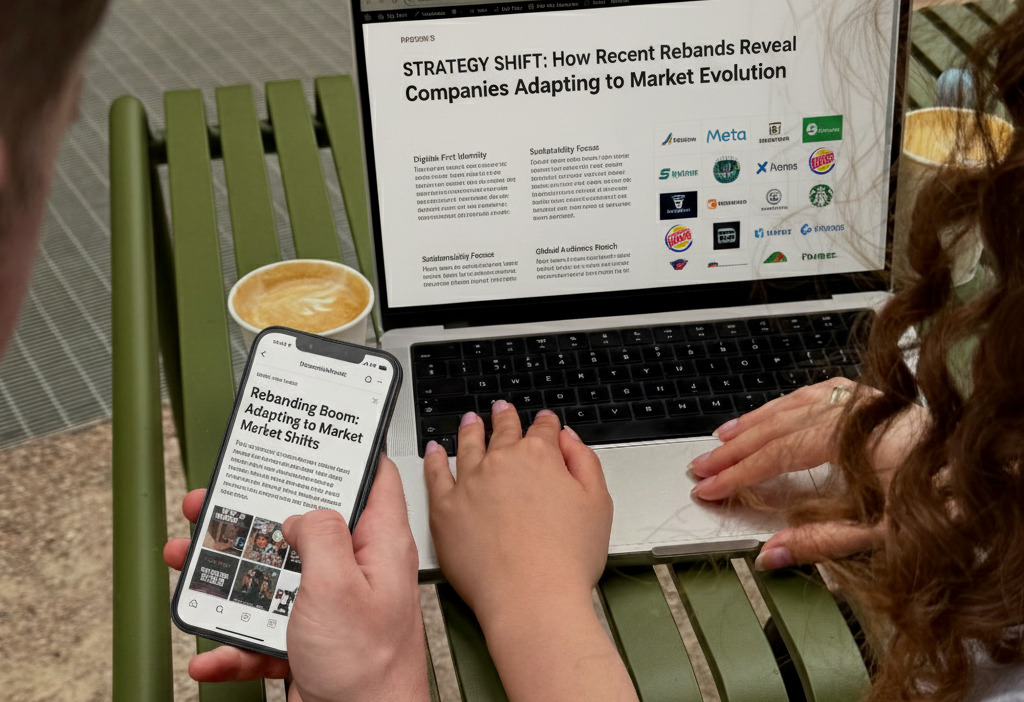The corporate landscape is not a static environment; it is a volatile ecosystem in constant flux. In this era of rapid digital transformation, changing consumer values, and unprecedented global challenges, a company’s brand identity is its most critical asset and, frequently, its most significant liability.
When a major corporation, a household name like Meta, Kia, or Johnson & Johnson, decides to shed its skin, it is not a mere cosmetic exercise. It is a calculated, strategic signal: a public acknowledgement that the old identity no longer aligns with the new reality of the business or the market positioning it seeks to claim. These recent rebrands are not vanity projects; they are strategic imperatives demonstrating precisely how companies are adapting to market shifts.
This long-form guide will move beyond the superficial analysis of logos and colour palettes. We will deconstruct the most instructive examples of successful company rebrands, analyse the foundational brand strategy that fuelled them, and provide a detailed framework your business can use to ensure its own brand evolution is a catalyst for sustainable growth.

The Three Core Drivers of Strategic Company Rebrand
A company rebrand is a high-stakes manoeuvre that can cost millions and risk decades of built-up brand equity. It is only undertaken when the internal business reality collides with an external market force that demands radical change. The forces driving this surge in corporate rebranding can be categorised into three major areas.
1. Adaptation to Digital Transformation and Technological Pivots
The digital age is the single most disruptive force in modern business. Companies that were once defined by a physical product or singular service must now signal their intent to lead a multi-platform, technology-forward future.
Case Study: Facebook to Meta - This is perhaps the most dramatic modern example of a rebrand driven by technological evolution. Facebook, a name deeply associated with a single social platform and a string of reputational crises, rebranded to Meta to signal a tectonic shift in its business focus. The new brand identity and name are a strategic declaration that the company is no longer a social media firm but a leader in the nascent Metaverse, AI, and immersive digital experiences. The brand strategy here was to proactively claim a new, future-defining market positioning and distance itself from past controversies.
2. The Shift to New Consumer Values and Societal Inclusivity
Consumer expectations have shifted from mere product quality to demanding social accountability, sustainability, and inclusivity. Brands whose identities were perceived as exclusionary or outdated are now being compelled to adapt or risk irrelevance.
Case Study: Victoria’s Secret’s Brand Refresh: For years, Victoria’s Secret was defined by the "Angel" aesthetic. However, as consumers, particularly younger demographics, began to prioritise empowerment, diversity, and body positivity, the brand’s image became a liability. Their subsequent brand refresh and repositioning, which replaced the Angels with the "VS Collective" of diverse women, was a necessary move to align their brand identity with a new, progressive set of core customer values and stave off further market erosion. This rebrand was a direct response to a cultural market shift.
3. Expansion Beyond the Core Product for New Market Positioning
Many legacy brands find their names too limiting as they diversify their offerings. A successful brand strategy often requires a name or logo that can stretch across multiple product lines or into entirely new industries.
Case Study: Dunkin’ Doughnuts to Dunkin’: By dropping "Doughnuts" from its name in 2019, Dunkin’ executed a masterclass in strategic streamlining. The simplified name and logo signalled that the brand was shifting its focus from being a pure-play doughnut shop to an all-day, beverage-first café chain, a direct competitive play against Starbucks. This subtle but effective brand refresh allowed the company to expand its service offerings and solidify its identity as a convenient, all-day option, achieving a more expansive market positioning.
Deconstructing Successful Company Rebrands: From Motors to Mobility
The most compelling rebranding examples are those that are clearly underpinned by a new, well-defined business strategy. They aren't just aesthetic updates; they reflect a new operating model.
The Nokia and Kia Rebranding Examples: Signalling Strategic Transformation
Two recent rebrands exemplify the need to adapt to a changing industrial landscape, the pivot to electric mobility and the shift from a consumer-to-B2B focus.
Nokia: A Strategic Pivot from Consumer Legacy to B2B Future
For 45 years, the Nokia logo was synonymous with the early mobile phone era, a legacy of consumer reliability. However, the modern Nokia is a technology giant focused on B2B networking, 5G infrastructure, and industrial digitalisation.
The Shift: The new, sleek, and angular logo, which removed the iconic blue, was a clear signal of this massive internal pivot. The brand's evolution shifted from emotional nostalgia to a modern, angular, and high-tech aesthetic.
The Strategy: The primary brand strategy was to eliminate the decades-old consumer association that was confusing to potential business clients. The new identity clearly positions Nokia as a leader in enterprise technology, essential for its new market positioning in the competitive telecom infrastructure space.
Kia: Driving Brand Evolution in the Electric Era
Kia's 2021 rebrand was an aggressive move to position itself at the forefront of the electric vehicle (EV) revolution.
The Shift: Kia dropped the word "Motors" from its name (implicitly) and introduced a dramatically different, handwritten-signature-style logo, along with the new slogan: "Movement that inspires." The new identity is sleek, futuristic, and connected.
The Strategy: This company's rebrand goes deeper than visuals. It signifies a wholesale transition from a value-driven traditional car manufacturer to a bold leader in electric mobility. The aesthetic change, with its sleek, connected lines, is a visual representation of their forward-looking business strategy, giving them a significant advantage in perception over legacy auto brands in the EV race.
A Strategic Framework for Brand Adaptation: Building a Future-Proof Brand Strategy
A successful brand strategy for a rebrand must follow a rigorous, research-led process. It's not about what looks good; it's about what effectively communicates your new value proposition.
1. Conduct a Comprehensive Brand Audit (The "Why")
Before commencing any design work, conduct a thorough and objective brand audit. This involves:
Internal Alignment: Assess whether your current brand identity accurately reflects your mission, vision, and core values, especially if they've changed.
Market Perception vs. Reality: Use surveys, focus groups, and sentiment analysis (social media/news) to understand precisely how customers, prospects, and competitors perceive your current brand. This helps identify the market shifts you are currently failing to address.
Competitive Analysis: Identify gaps in the market positioning that your new brand can uniquely fill.
2. Define the New Brand Platform and Positioning (The "What")
The most critical step is defining the new brand platform that will guide all creative and communication decisions.
Core Message: What is the single, differentiated claim your brand can own? (e.g., Kia owns 'Movement that inspires,' not just 'affordable cars').
Target Audience: Is the rebrand designed to re-engage an existing, ageing audience or attract a new, younger demographic (like the use of flat design/2D logos for digital channels)?
Brand Evolution Roadmap: Determine whether you need a subtle brand refresh (visual tweaks) or a total overhaul (new name, logo, messaging).
3. Execution and Consistency: The Brand Identity Rollout (The "How")
The execution determines the success of the company rebrand. Inconsistency is the biggest killer of a new brand identity.
Internal Launch First: Your employees must be the first to understand, internalise, and champion the new brand. They are the frontline communicators of your new brand strategy.
Digital-First Design: Ensure all new visual elements (logos, colours, typography) are optimised for a digital environment (e.g., flat, scalable, and responsive for small screens). Modern branding trends prioritise digital adaptability.
Cross-Channel Cohesion: From your website and social media to packaging, stationery, and internal email signatures, every single customer touchpoint must flawlessly and immediately reflect the new identity. This requires meticulous adherence to comprehensive brand guidelines.
Strategic Communications: Launch with a narrative, not just an announcement. Explain the why, the market shifts you are reacting to and the future you are building, to give stakeholders a reason to buy into the change.
Avoiding Rebranding Pitfalls: Lessons from Misaligned Brand Evolution
Not all rebrands are successful examples of rebranding. Failures often stem from mistaking a cosmetic change for a strategic one or losing touch with core customer loyalty.
The Twitter-to-X Misstep: The change from Twitter to X is an extreme example of a rebrand prioritising a CEO's vision over established brand equity and customer familiarity. While the stated goal was to signal a shift to an "everything app," the immediate, forced change abandoned one of the world's most recognisable brand identities and created confusion. The lesson: brand evolution must be a bridge to the future, not a complete, disorienting severance from a brand’s history, unless reputation damage is irreversible.
Loss of Distinctiveness: Some companies, in an effort to follow generic branding trends like using flat design or simplified, sans-serif logos (a phenomenon sometimes called 'Blanding'), lose the unique character that made them recognisable. While digital adaptability is crucial, the new identity must still maintain enough distinctiveness for effective market positioning.
A successful rebrand must always maintain a through-line of brand equity and customer recognition, even as it adapts to new market realities.
The Long-Term Value: Brand Strategy as a Competitive Differentiator
In today's competitive landscape, a brand strategy serves as the master plan for sustainable growth. The successful company rebrands we've examined underscore a simple truth: a brand is not just who you are; it's a promise of who you will become in a changing world.
By proactively managing your brand evolution, you can ensure your company is not merely surviving market shifts but leading them. A strategic company rebrand is the ultimate expression of business agility, allowing you to:
Attract New Talent: A forward-looking, modern brand attracts higher-quality, digitally fluent employees.
Reposition Against Competitors: A clear new identity carves out a unique, defensible space in the market (e.g., Kia vs. its peers).
Future-Proof the Business: By aligning the brand with long-term strategic goals (Metaverse, EV mobility), the company signals its commitment to innovation, building investor and consumer confidence.
Ultimately, investing in a robust brand strategy is an investment in your company’s next decade of relevance and success. It is the only way to ensure your brand identity remains a powerful driver of revenue and loyalty, rather than an anchor to the past.
Is your company's identity ready for the next decade of digital and cultural disruption?
Whether you require expert branding services in Manchester to revitalise your company’s image or dedicated branding management to maintain consistency across global touchpoints, The Social Bay is your strategic partner.
To develop a data-driven, future-proof brand strategy and execute a seamless, impactful company rebrand that maximises your market positioning, contact us for a consultation today.









